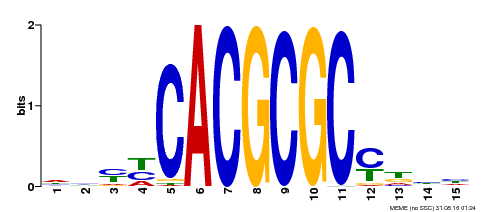| Signature Domain? help Back to Top |
 |
| No. |
Domain |
Score |
E-value |
Start |
End |
HMM Start |
HMM End |
| 1 | FAR1 | 90.7 | 2e-28 | 66 | 154 | 2 | 91 |
FAR1 2 fYneYAkevGFsvrkskskkskrngeitkrtfvCskegkreeekkktekerrtraetrtgCkaklkvkkekdgkwevtkleleHnHelap 91
fY+eYAk++GF++++++s++sk+++ +++++f Cs++g + e++++ +++r++++++t+Cka+++vk++ dgkw +++++++HnHel p
AT4G15090.1 66 FYQEYAKSMGFTTSIKNSRRSKKTKDFIDAKFACSRYGVTPESESS-GSSSRRSTVKKTDCKASMHVKRRPDGKWIIHEFVKDHNHELLP 154
9***************************************999998.9999999*********************************975 PP
|
| Publications
? help Back to Top |
- Hudson M,Ringli C,Boylan MT,Quail PH
The FAR1 locus encodes a novel nuclear protein specific to phytochrome A signaling.
Genes Dev., 1999. 13(15): p. 2017-27
[PMID:10444599] - Wang H,Deng XW
Arabidopsis FHY3 defines a key phytochrome A signaling component directly interacting with its homologous partner FAR1.
EMBO J., 2002. 21(6): p. 1339-49
[PMID:11889039] - McCormac AC,Terry MJ
Light-signalling pathways leading to the co-ordinated expression of HEMA1 and Lhcb during chloroplast development in Arabidopsis thaliana.
Plant J., 2002. 32(4): p. 549-59
[PMID:12445126] - Wang H, et al.
Analysis of far-red light-regulated genome expression profiles of phytochrome A pathway mutants in Arabidopsis.
Plant J., 2002. 32(5): p. 723-33
[PMID:12472688] - Hudson ME,Lisch DR,Quail PH
The FHY3 and FAR1 genes encode transposase-related proteins involved in regulation of gene expression by the phytochrome A-signaling pathway.
Plant J., 2003. 34(4): p. 453-71
[PMID:12753585] - Lin R,Wang H
Arabidopsis FHY3/FAR1 gene family and distinct roles of its members in light control of Arabidopsis development.
Plant Physiol., 2004. 136(4): p. 4010-22
[PMID:15591448] - Lin R, et al.
Transposase-derived transcription factors regulate light signaling in Arabidopsis.
Science, 2007. 318(5854): p. 1302-5
[PMID:18033885] - Genoud T, et al.
FHY1 mediates nuclear import of the light-activated phytochrome A photoreceptor.
PLoS Genet., 2008. 4(8): p. e1000143
[PMID:18670649] - Lin R, et al.
Discrete and essential roles of the multiple domains of Arabidopsis FHY3 in mediating phytochrome A signal transduction.
Plant Physiol., 2008. 148(2): p. 981-92
[PMID:18715961] - Shen Y, et al.
Phytochrome A mediates rapid red light-induced phosphorylation of Arabidopsis FAR-RED ELONGATED HYPOCOTYL1 in a low fluence response.
Plant Cell, 2009. 21(2): p. 494-506
[PMID:19208901] - Domergue F, et al.
Three Arabidopsis fatty acyl-coenzyme A reductases, FAR1, FAR4, and FAR5, generate primary fatty alcohols associated with suberin deposition.
Plant Physiol., 2010. 153(4): p. 1539-54
[PMID:20571114] - Li J, et al.
Arabidopsis transcription factor ELONGATED HYPOCOTYL5 plays a role in the feedback regulation of phytochrome A signaling.
Plant Cell, 2010. 22(11): p. 3634-49
[PMID:21097709] - Li G, et al.
Coordinated transcriptional regulation underlying the circadian clock in Arabidopsis.
Nat. Cell Biol., 2011. 13(5): p. 616-22
[PMID:21499259] - Ouyang X, et al.
Genome-wide binding site analysis of FAR-RED ELONGATED HYPOCOTYL3 reveals its novel function in Arabidopsis development.
Plant Cell, 2011. 23(7): p. 2514-35
[PMID:21803941] - Heyndrickx KS,Vandepoele K
Systematic identification of functional plant modules through the integration of complementary data sources.
Plant Physiol., 2012. 159(3): p. 884-901
[PMID:22589469] - Tang W, et al.
Transposase-derived proteins FHY3/FAR1 interact with PHYTOCHROME-INTERACTING FACTOR1 to regulate chlorophyll biosynthesis by modulating HEMB1 during deetiolation in Arabidopsis.
Plant Cell, 2012. 24(5): p. 1984-2000
[PMID:22634759] - Tang W, et al.
FAR-RED ELONGATED HYPOCOTYL3 and FAR-RED IMPAIRED RESPONSE1 transcription factors integrate light and abscisic acid signaling in Arabidopsis.
Plant Physiol., 2013. 163(2): p. 857-66
[PMID:23946351] - Jin J, et al.
An Arabidopsis Transcriptional Regulatory Map Reveals Distinct Functional and Evolutionary Features of Novel Transcription Factors.
Mol. Biol. Evol., 2015. 32(7): p. 1767-73
[PMID:25750178] - Wang C, et al.
SCAB3 Is Required for Reorganization of Actin Filaments during Light Quality Changes.
J Genet Genomics, 2015. 42(4): p. 161-8
[PMID:25953354] - Wang H,Wang H
Multifaceted roles of FHY3 and FAR1 in light signaling and beyond.
Trends Plant Sci., 2015. 20(7): p. 453-61
[PMID:25956482] - Wang W, et al.
A pair of light signaling factors FHY3 and FAR1 regulates plant immunity by modulating chlorophyll biosynthesis.
J Integr Plant Biol, 2016. 58(1): p. 91-103
[PMID:25989254] - Ma L, et al.
Arabidopsis FHY3 and FAR1 Regulate Light-Induced myo-Inositol Biosynthesis and Oxidative Stress Responses by Transcriptional Activation of MIPS1.
Mol Plant, 2016. 9(4): p. 541-57
[PMID:26714049] - Siddiqui H,Khan S,Rhodes BM,Devlin PF
FHY3 and FAR1 Act Downstream of Light Stable Phytochromes.
Front Plant Sci, 2016. 7: p. 175
[PMID:26941752] - Liu L,Li B,Liu X
FAR-RED ELONGATED HYPOCOTYL3 promotes floral meristem determinacy in Arabidopsis.
Plant Signal Behav, 2016. 11(10): p. e1238545
[PMID:27660915] - Ma L,Xue N,Fu X,Zhang H,Li G
Arabidopsis thaliana FAR-RED ELONGATED HYPOCOTYLS3 (FHY3) and FAR-RED-IMPAIRED RESPONSE1 (FAR1) modulate starch synthesis in response to light and sugar.
New Phytol., 2017. 213(4): p. 1682-1696
[PMID:27859295] - Liu Y, et al.
Light and Ethylene Coordinately Regulate the Phosphate Starvation Response through Transcriptional Regulation of PHOSPHATE STARVATION RESPONSE1.
Plant Cell, 2017. 29(9): p. 2269-2284
[PMID:28842534] - Joly-Lopez Z, et al.
Abiotic Stress Phenotypes Are Associated with Conserved Genes Derived from Transposable Elements.
Front Plant Sci, 2017. 8: p. 2027
[PMID:29250089]
|





